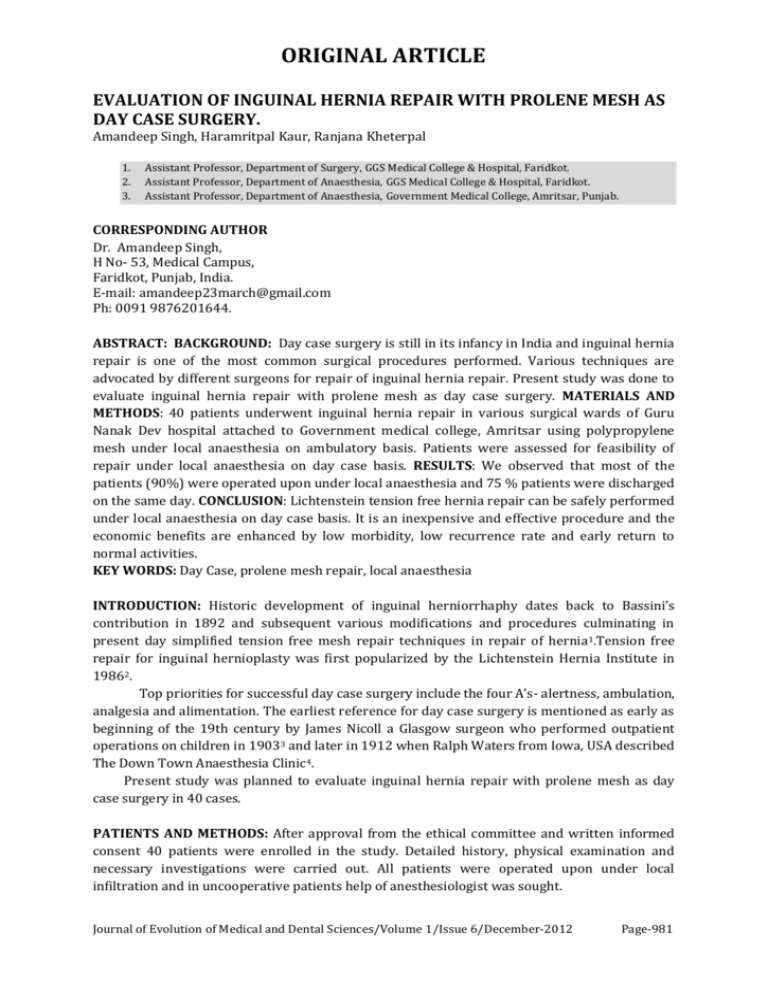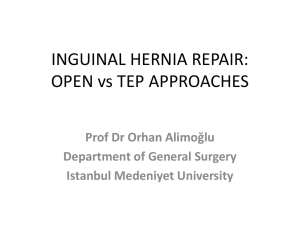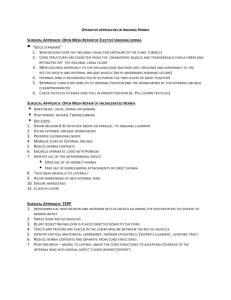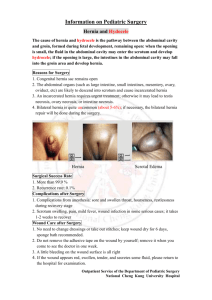EVALUATION OF INGUINAL HERNIA REPAIR WITH
advertisement

ORIGINAL ARTICLE EVALUATION OF INGUINAL HERNIA REPAIR WITH PROLENE MESH AS DAY CASE SURGERY. Amandeep Singh, Haramritpal Kaur, Ranjana Kheterpal 1. 2. 3. Assistant Professor, Department of Surgery, GGS Medical College & Hospital, Faridkot. Assistant Professor, Department of Anaesthesia, GGS Medical College & Hospital, Faridkot. Assistant Professor, Department of Anaesthesia, Government Medical College, Amritsar, Punjab. CORRESPONDING AUTHOR Dr. Amandeep Singh, H No- 53, Medical Campus, Faridkot, Punjab, India. E-mail: amandeep23march@gmail.com Ph: 0091 9876201644. ABSTRACT: BACKGROUND: Day case surgery is still in its infancy in India and inguinal hernia repair is one of the most common surgical procedures performed. Various techniques are advocated by different surgeons for repair of inguinal hernia repair. Present study was done to evaluate inguinal hernia repair with prolene mesh as day case surgery. MATERIALS AND METHODS: 40 patients underwent inguinal hernia repair in various surgical wards of Guru Nanak Dev hospital attached to Government medical college, Amritsar using polypropylene mesh under local anaesthesia on ambulatory basis. Patients were assessed for feasibility of repair under local anaesthesia on day case basis. RESULTS: We observed that most of the patients (90%) were operated upon under local anaesthesia and 75 % patients were discharged on the same day. CONCLUSION: Lichtenstein tension free hernia repair can be safely performed under local anaesthesia on day case basis. It is an inexpensive and effective procedure and the economic benefits are enhanced by low morbidity, low recurrence rate and early return to normal activities. KEY WORDS: Day Case, prolene mesh repair, local anaesthesia INTRODUCTION: Historic development of inguinal herniorrhaphy dates back to Bassini’s contribution in 1892 and subsequent various modifications and procedures culminating in present day simplified tension free mesh repair techniques in repair of hernia 1.Tension free repair for inguinal hernioplasty was first popularized by the Lichtenstein Hernia Institute in 19862. Top priorities for successful day case surgery include the four A’s- alertness, ambulation, analgesia and alimentation. The earliest reference for day case surgery is mentioned as early as beginning of the 19th century by James Nicoll a Glasgow surgeon who performed outpatient operations on children in 19033 and later in 1912 when Ralph Waters from Iowa, USA described The Down Town Anaesthesia Clinic4. Present study was planned to evaluate inguinal hernia repair with prolene mesh as day case surgery in 40 cases. PATIENTS AND METHODS: After approval from the ethical committee and written informed consent 40 patients were enrolled in the study. Detailed history, physical examination and necessary investigations were carried out. All patients were operated upon under local infiltration and in uncooperative patients help of anesthesiologist was sought. Journal of Evolution of Medical and Dental Sciences/Volume 1/Issue 6/December-2012 Page-981 ORIGINAL ARTICLE A mixture of lignocaine (2%) 3.5mg/kg and bupivacaine (0.5%) 2mg/kg were used for infiltration. 3 ml of sodium-bi-carbonate (7.5%) was added to the solution. The patient suffering from any bleeding disorder, having obstructed or strangulated inguinal hernia and Nyhus type I hernia were excluded from study. OPERATIVE TECHNIQUE: Operation was based upon Lichtenstein repair, done under local anaesthesia with excision of indirect sac and inversion of direct sac. A prolene mesh 3” x 6” was used as an onlay patch for hernia floor repair . A slit was made in mesh to accommodate the cord. Mesh was fixed to inguinal ligament inferiorly, conjoint tendon superiorly and transversalis fascia with interrupted prolene 2-0 suture. The closure of external oblique aponeurosis, subcutis and cutis was done in layers . Postoperative management In the post operative period patients were encouraged to be ambulatory soon after the operation and were discharged on the evening of operation if all the discharge criteria were met . On discharge, an oral combination of Diclofenac Sodium 50 mg, acetaminophen 500 mg and oral antibiotics were prescribed for 5 days. Discharge criteria used were Vital signs must have been stable for at least 1 hour and patient must be oriented to person, place and time. Able to retain orally administered fluid. Able to walk without assistance, void and dress. The patient must not have more than minimal nausea or vomiting, excessive pain or any bleeding. Follow up The patients were followed up for 6 months at 3 weeks, 3 months and 6 months for any recurrences or complications. RESULTS: In the study all patients were males. The maximum incidence of the hernia was found in the 7th decade (60-69 years) of life. The size of the hernia was small to massive. Types of hernias are shown in figure 1. 36 (90%) cases were done under local anaesthesia, two patients required spinal anaesthesia while two patients required additional sedation during surgery (figure2).30 patients were discharged on the same day (figure 3).All the patients were given follow up. All the patients turned up for regular follow ups. Various complications seen are listed in figure 4 . DISCUSSION: Recent advances in anaesthetic and surgical techniques along with escalating health care cost have resulted in increasing number of surgical procedures being performed on day case basis. The life time risk of undergoing hernia operation is 27% for men and 3% for women 5. The Lichtenstein tension free repair opened a new era in groin hernia repair with superior results over prior methods. In this repair, the inguinal canal is approached from an open anterior approach after diving the skin, scarpa fascia and external oblique aponeurosis. The cord is examined for an indirect sac, any direct hernia is reduced and the floor is reinforced with a piece of flat polypropylene mesh that is sewn to the conjoint tendon and the shelving edge of the inguinal ligament. The mesh is slit to accommodate the cord structure .This repair has a very low learning curve and can be readily performed under local anaesthesia specially in patients who are at high risk for general anaesthesia. Journal of Evolution of Medical and Dental Sciences/Volume 1/Issue 6/December-2012 Page-982 ORIGINAL ARTICLE Open mesh repair popularized by Lichtenstein has significantly reduced recurrences compared with conventional open nonmesh repairs6. This finding was also supported by several other studies and it has been stated that using a mesh for open repair reduces recurrence rate by 50% to 75% when compared with open suture repair 7-8. The present study was done to assess the feasibility of Lichtenstein mesh repair for inguinal hernia under local anaesthesia as day case surgery. 36 (90%) cases were done under local anaesthesia. Two (5%) cases were done under spinal anaesthesia because one was associated with undescended testis and other was recurrent hernia. In two (5%) cases help of anaesthesiologist was sought because patients were very uncooperative during operation. 30 patients were discharged on the day of operation as day case basis. Five patients were discharged on the first post operative day because of complaint of moderate to severe pain on the day of operation. Three (7.50%) patients were discharged within five post-operative day. Two (5%) patients were discharged after suture removal on 7th post-operative day. There were three (7.5%) cases of wound infection treated by antibiotics and anti inflammatory drugs along with antiseptic dressing. There was a single case of wound haematoma treated by sterile syringe aspiration under all possible asepsis. The patients were prescribed anti inflammatory drugs and antibiotics orally. There were two (5.0%) patients of scrotal swelling who were treated by scrotal support and anti-inflammatory drugs. Tension free repair of 1098 inguinal hernia in 1017 patients has been assessed. The operation was conducted under local anaesthesia and the inguinal canal floor was reinforced by polypropylene mesh. Patients were discharged home on the same day. There was no mortality, no urinary complication and there was only one case of venous thrombosis. There was one recurrence after a primary hernia repair and two patients have developed recurrence after repair of a recurrent hernia. The overall sepsis rate was 0.9% . None of the prosthesis required removal9. In our study there was not even a single case of recurrence and mesh removal after operation. In study for comparison of local, spinal and general anaesthesia for inguinal herniorrhaphy it was shown that local anaesthesia is suitable for day case hernia repair with fewer postoperative problems10. Similarly 2906 adult patients with 3,175 primary inguinal hernia had repair on a day case basis under local anaesthesia by an open tension free mesh technique. Out of these patients 20 (0.8%) patients required general anaesthesia. All patients were discharged two hours after operation. There was no case of urinary retention and testicular atrophy. The incidence of deep infection was 0.3% and of haematoma 2%. There were eight recurrences within 18 months to 5 years follow up11. In our study, there was no case of urinary retention, testicular atrophy, mesh removal or recurrence. There was only one case of wound haematoma, one case of each superficial and deep wound infection and two cases of testicular swelling. Lichtenstein repair on 64 patients of inguinal hernia to assess the feasibility of open tension free mesh repair of inguinal hernia on ambulatory basis showed that 84.4% patients were safely operated with minimal morbidity rate of 14.0%12. A study on 1000 patients of primary and recurrent hernia to evaluate the feasibility of unmonitored local anaesthesia showed that unmonitored local anaesthesia was converted to general anaesthesia in only five cases. Two patient required anaesthesia monitory care . Surgery was completed under unmonitored local anaesthesia in 993 cases (99.3%). Out of total patients 961 were discharged on the day of surgery13. In our study 36 patients out of 40 were Journal of Evolution of Medical and Dental Sciences/Volume 1/Issue 6/December-2012 Page-983 ORIGINAL ARTICLE successfully operated under local anaesthesia and two patients required spinal anaesthesia. Only two patients required sedation intraoperatively. CONCLUSION: Lichtenstein tension free hernia repair has opened a new era in hernia surgery and highly successful results of technique are confirmed by this small prospective study. It can be safety performed under local anaesthesia on day case basis. It is an inexpensive and effective procedure and the economic benefits are enhanced by low morbidity, low recurrence rate and early return to normal activities. REFERENCES: 1. 2. 3. 4. 5. 6. 7. 8. 9. 10. 11. 12 13. Rutkow IM, Robbins AW: Demographic, classificatory and socioeconomic aspects of hernia repair in the united states. Surg Clin North Am.1993; 73: 413. Velitchkov NG, Losanoff JE, Kjossev KT, Grigorov GI, Kirov GK and Losanoff CE: The lichtenstein open tension free inguinal hernia repair using a new prosthetic mesh balgarian irresorbable ampoxen. Int Surg. 1996; 81: 205-206. Lictenstein IL, Shulman AG: Ambulatory outpatient hernia surgery, including a new concept, introducing tension free repair. Surg.1986; 71: 1-7. Awad SS, Fagan SP: Current approaches to inguinal hernia repair. The Amer. Jour of Sur. 2004;9-16. Schouten N,Dalen TV, Smakman N , Elias SG, Clevers GJ, Verleisdonk EJMM et al: The effect of ultrapro or prolene mesh on post operative pain and well being following endoscopic totally extraperitoneal (TEP) hernia repair (TULP) : study protocol for a randomized controlled trial. Trials 2012;13:76. EU Hernia Trialists collaboration. Mesh Compared with non mesh method of open groin hernia repair. Systematic review of randomized controlled trials. Br J Surg. 2000; 87: 855-859. Grant AM, EU Hernia Trialists Collaboration: Open Mesh versus non-mesh repair of groin hernia repair: metaanalysis of randomized trials based on individual data. Hernia.2002; 6: 130-136. EU hernia trialists collaboration. Repair of groin hernia with synthetic mesh. Ann Surg.2002; 235: 322-332. Kark AE, Kurzer M, Waters KJ: Tension-free mesh hernia repair: review of 1098 cases using local anaesthesia in a day unit. Ann R Coll Surg Engl.1995;77(4): 299-304. Ozgun H, Kurt MN, Kurt I, Cevikel MH: Comparison on local, spinal and general anaesthesia for inguinal hernioraphy. Eur Jour Surg.2003; 168(8): 455-459. Kark AE, Kurzer MN, Belsham PA: Three thousand one hundred seventy five primary inguinal hernia repairs advantages of ambulatory open mesh repair using local anaesthesia. J Am Coll Surgery.1998; 186: 447-456. Shrestha SK, Sharma VK : Outcome of Lichtenstein operation: a prospective evaluation of sixty-four patients. Nepal Med Coll J.2006;8(4): 230-233. Callesen T, Bech K, Kehlet H: One thousand consecutive inguinal hernia repair under unmonitored local anaesthesia. Anesth Analg .2001; 93: Journal of Evolution of Medical and Dental Sciences/Volume 1/Issue 6/December-2012 Page-984 ORIGINAL ARTICLE FIGURE 1 TYPE OF HERNIA Right indirect inguinal hernia 21(52.50%) Right direct inguinal hernia 7(17.50%) Left indirect inguinal hernia 8(20.0%) Left direct inguinal hernia 4(10.0%) Recurrent inguinal hernia 1(2.50%) Total 40 (100%) FIGURE 2 SHOWING TYPE OF ANAESTHESIA 40 35 30 No. of patients 25 20 15 10 5 0 Local Spinal Extra sedation with ketamine or midazolam General Type of anaesthesia Journal of Evolution of Medical and Dental Sciences/Volume 1/Issue 6/December-2012 Page-985 ORIGINAL ARTICLE FIGURE 3 SHOWING POSTOPERATIVE HOSPITAL STAY IN DAYS 30 25 No. of patients 20 15 10 5 0 0 1 2 3 5 7 Hospital stay (days) FIGURE 4 - SHOWING POSTOPERATIVE COMPLICATIONS Postoperative complications No. of patients Percentage Urinary retention - - Wound haematoma 1 2.50 Infection of wound (superficial) 2 5.00 Infection of wound (deep) 1 2.50 Testicular atrophy - - Mesh removal - - Testicular neuralgia - - Testicular swelling 2 5.00 Recurrence - - Journal of Evolution of Medical and Dental Sciences/Volume 1/Issue 6/December-2012 Page-986






